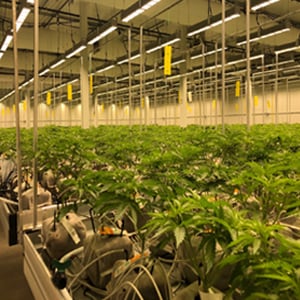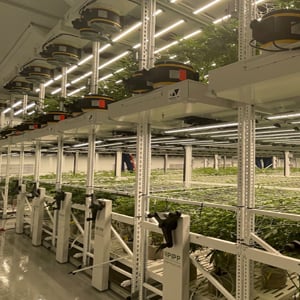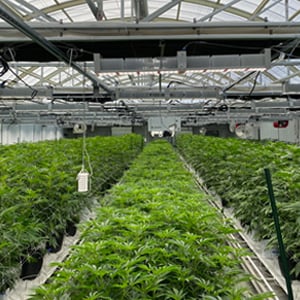Controlled Environment Agriculture: The Future of Horticulture Lies in Control
Controlled Environment Agriculture (CEA), combines horticultural, engineering, and plant science practices to create the most favorable growing conditions possible within a controlled indoor space.
Controlled Environment Agriculture (CEA) facilities utilize the latest in engineering and science-based approaches to maximize plant production, quality, and yield. It's an approach that happens across a variety of environments. But, the most common is indoor grow rooms, vertical farms, and greenhouses.
An Old Approach to Cultivation, Applied to Cannabis
Controlled Environment Agriculture is a new concept for some, but it has been around for centuries. Evidence shows that the first practice of controlling a plant's environment came about during the Roman Empire. However, the first greenhouses date back to the 1600s, with the first 'modern' design appearing around 1670.
Because of the level of precision, CEA has become the preferred method of cultivation for many commercial cannabis growers. Maintaining total control over the environment helps cultivators achieve maximum yield and the highest quality.
Furthermore, CEA facilities have the distinct advantage of being impervious to weather fluctuation. This translates into growing cannabis year-round, not just in the summer months.
The concept of controlling an environment to manipulate plant growth is by no means a new one, but modern advancements have pushed the industry forward with incredible precision.
What is Controlled Environment Agriculture (CEA)?
In layman's terms, this concept is about controlling conditions within a designated grow space. This translates into cultivation methodology through facility design and equipment.
At its most basic level, controlling a growing environment consists of manually manipulating factors that impact a plant's growth, such as lighting, temperature, humidity, and grow medium conditions.
Much of the guesswork and manual manipulation has been automated thanks to advances in grow light technology, software, environment control and hydroponic techniques.
Modern CEA operations are highly specialized facilities designed to promote optimal growing conditions in the most cost-effective means possible. These facilities come with a high capital investment during the build-out but end up saving OPEX and maintenance costs down the line.
Why are they so efficient? All cultivation systems, including lighting, water, and fertilizers, work in concert to deliver exactly what each plant requires when it requires it. Additionally, much of the work is automated. This wastes little energy, resources, or labor.
Of course, no two CEA facilities are the same, and various factors can contribute to an operation's needs, such as geographic orientation, altitude, and climate.
Taking all of these factors into account, along with other factors such as space limitations and regulations, can help designers work within the needs and constraints of an operation's grow space.
CEA Methods and Approaches
Some CEA facilities operate fully indoors with no natural light to supplement the operation's grow lighting. Others take place in greenhouses that allow ample natural light in and offer the benefit of integrated vents and windows into the design.
Because so much depends on the specifications of the cultivation facility, there is no perfect one-size-fits-all approach to CEA. Instead, licensed producers need to examine the proposed facility, regional limitations, and local regulations to make informed decisions based on the specific needs of their operation and the crop they are growing.
Indoor Growing

Many CEA facilities are fully indoor, operating all year round under the bright, vibrant glow of grow lights. Indoor operations put complete control of the grow room's conditions into the hands of the cultivator, as there are no outside environmental inputs. The grower controls everything from photoperiod to temperature to humidity to CO2 levels.
Indoor cultivation has long been the preferred method for commercial cannabis growers as it offers a discrete and reliable means to create the plant's premier growing conditions.
Let's look at some of the specific advantages and potential disadvantages of an indoor grow setup.
Advantages
- Complete control over all aspects of the grow environment
- Possible to tailor light spectrum to plants' specific needs
- Possible to grow year-round
- Excellent mitigation of outside factors, including inclement weather, pests, and disease
- Replication of grow conditions from one crop to the next
Disadvantages
- Costly to set up, maintain and operate
- Requires additional systems to maintain conditions, particularly HVAC and especially Dehumidification
- Onus on growers to understand plants' morphology, life cycle, and needs
Vertical Farming

Though technically a variation on indoor growing, vertical farming is a relatively recent development for cannabis cultivation.
With the advent of LED grow lighting, growers discovered that they could place their lights far closer to their plant canopy without their plants sustaining the damage of older, outdated grow lights, such as high-pressure sodium (HPS).
If lights are hung within inches of the plant canopy, the rest of the space between the lights and the ceiling is going to waste.
Cultivators began to build up instead of out with the development of lightweight, vertical racking systems. By mounting LED grow lights onto vertical racks, growers can create a "shelving" system, enabling multiple layers of plants to be stacked atop one another.
This means that growers can fit many times more plants into the same allotted space than they previously could.
Advantages
- Complete control over all aspects of the grow environment
- Possible to tailor light spectrum to plants' specific needs
- Possible to grow year-round
- Excellent mitigation of outside factors, including inclement weather, pests, and disease
- Replication of grow conditions from one crop to the next
- Much more efficient use of real estate
Disadvantages
The most expensive upfront facility investment- Requires additional systems to maintain conditions, particularly HVAC and dehumidification
- Onus on growers to understand plant's morphology, life cycle, and needs
- Greater difficulty in accessing the plants with some systems
Greenhouse Growing
 The use of horticultural lighting inside a greenhouse may seem somewhat redundant, as greenhouses are specifically designed to allow maximum permeation of sunlight into the grow space.
The use of horticultural lighting inside a greenhouse may seem somewhat redundant, as greenhouses are specifically designed to allow maximum permeation of sunlight into the grow space.
But, LED grow lighting in a greenhouse can create particularly favorable results. In addition to offering the grower the opportunity to work with and beyond the sun's natural schedule, grow lighting can also supplement the spectrum of light that plants receive during different times of the year.
As natural sunlight may contain more or less of certain wavelengths during winter or fall months, supplemental lighting ensures plants receive maximum amounts of full-spectrum lighting all year-round.
In addition, supplemental lighting in a greenhouse can be paired with other technologies, such as retractable awnings, to create light deprivation environments. Light deprivation allows greenhouse growers to recreate indoor growing conditions, including total control over lighting conditions and control of the photoperiod for plants.
During the spring and summer months, greenhouse growers maximize sunlight; then, during the fall and winter months, supplemental lights work to provide the same amount of "sunshine." Thanks to this supplementary lighting, greenhouses are no longer subject to the limitations of the changing seasons.
Advantages
- Possible to control lighting conditions with supplemental grow lights
- Reduces utility expenses by reducing total reliance on grow lights
- Year-round cultivation
- Possible to employ light deprivation practices
- The lowest upfront investment
Disadvantages
- Requires additional systems to maintain conditions, including retractable shades and light deprivation curtains as well as HVAC and Dehumidification systems
- Environment more challenging to control than true indoor operations especially if built in humid environments
TSRgrow: Controlled Environment Agriculture is Our Specialty
At TSRgrow, we've dedicated years of R&D to create a complete Controlled Environment Agriculture (CEA) solution for growers everywhere. We've tackled every aspect of CEA to offer our clients the most comprehensive, easiest-to-use design and interface, all with the intended purpose of maximizing yields while minimizing costs.
Remote Power Servers
By decoupling power supplies from our fixtures and replacing them with remotely-located power servers, we successfully eliminated excess light heat from the grow room. The result is a grow room with fewer temperature swings, thereby mitigating a great deal of HVACD operation to maintain grow room conditions and saving on total operating costs.
Consequently, fewer HVACD venting cycles means greater retention of ambient CO2, another cost-saving benefit.
Reduced Maintenance
Our remote power servers also help reduce fixture weight, making installation and maintenance straightforward. In addition, we have been able to eliminate contactors and relays from our LED lights, opting instead for plug' n' play technology, which makes replacing fixtures as simple as possible and reduces the upfront costs of building out.
Great for Vertical Farming
Reducing the weight of our fixtures by decoupling them from ballasts offers our clients increased flexibility over other light designs. The lightweight construction makes our fixtures perfect for vertical farming applications.
Our LED lights operate at significantly cooler temperatures than others, thanks to our Remote Power Server technology. This enables cultivators to fit more lights into a grow space without increasing temperatures, making our LED lights the perfect solution for vertical farms, which feature many lights in a small or confined space.
GROWHub
We didn't just stop with our advanced LED lights, though. We've also developed GROWHub, a proprietary software that grants the grower complete access to all grow room conditions, even remotely.
By pairing remote sensors throughout the grow room with our GROWHub software, growers can monitor and adjust environmental conditions and lighting levels in real-time on the go. Cultivators now have unparalleled control over grow room conditions, not just on-site.
TSRgrow: A Complete Solution for CEA
At TSRgrow, we're dedicated to designing and creating the most user-friendly CEA systems on the market. So whether you're designing from the ground up or retrofitting an existing operation, we'd love to sit down with you and discuss the variety of options that we are able to offer.
Contact us today to find out how TSRgrow can help you maximize your growing potential!
